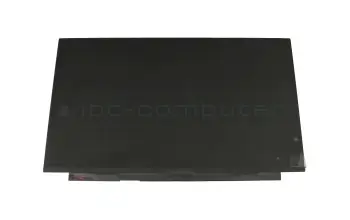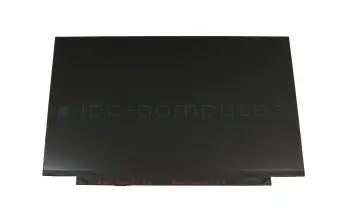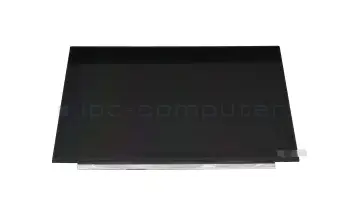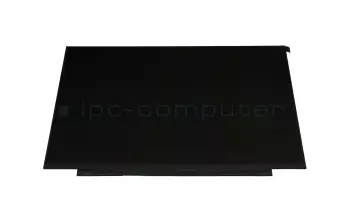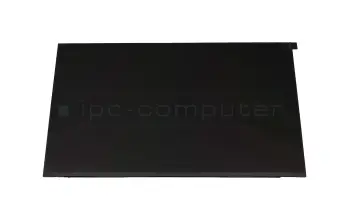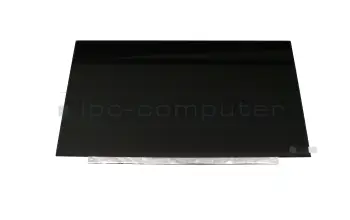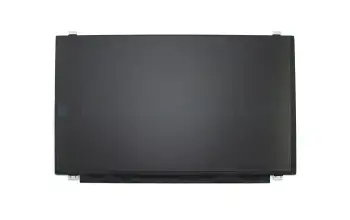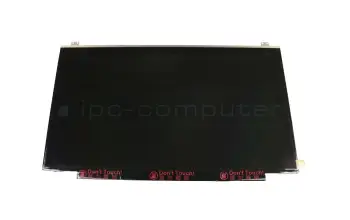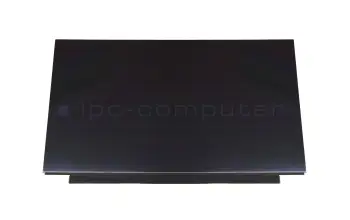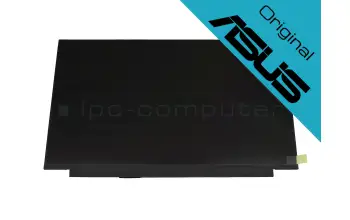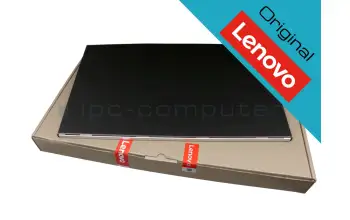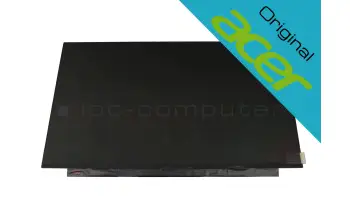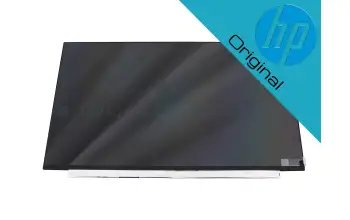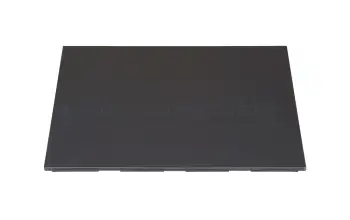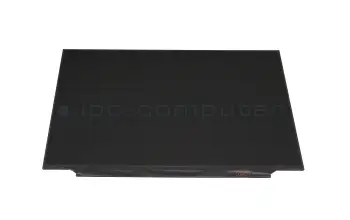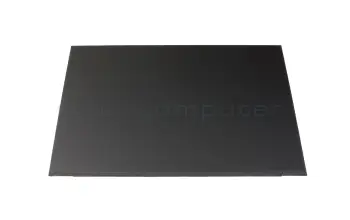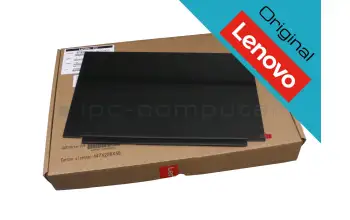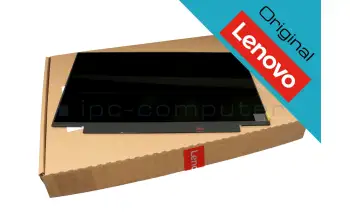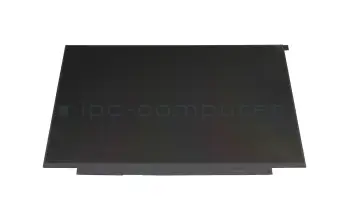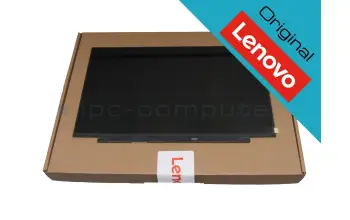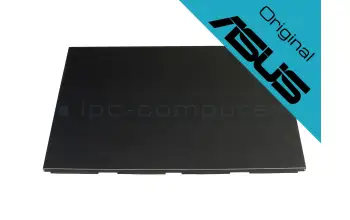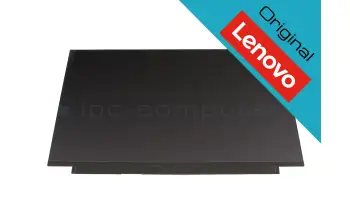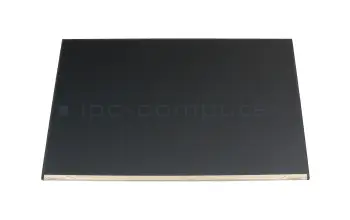Notebook/Laptop Displays
Advantages when ordering at IPC-Computer?
- We are official spare parts dealer of many notebook manufacturers, including Acer, Asus, Dell, HP, Lenovo and many more.
- Only displays of best quality from well-known manufacturers such as LG, Samsung, Chi Mei, AU Optronics, InnoLux, etc.
- Risk-free use through our quality assurance and service promise.
- Display replacement in our in-house notebook repair workshop at reasonable prices.
- Free technical support surrounding the topic of display exchange.

Find the right displays by model or features
N173FGE-L13 Chi Mei TN Display HD+ matt 60Hz

plus shipping charges
Installation in our notebook repair shop
Repair flat rate displayN173FGE-L13 Rev.C1 Innolux TN Display HD+ matt 60Hz

plus shipping charges
Installation in our notebook repair shop
Repair flat rate display0DXDWY Dell TN Display HD+ matt 60Hz

plus shipping charges
Installation in our notebook repair shop
Repair flat rate display04W4006 Lenovo TN Display HD matt 60Hz

plus shipping charges
Installation in our notebook repair shop
Repair flat rate displayPV156FHM-N20 BOE IPS Display FHD matt 60Hz

plus shipping charges
Installation in our notebook repair shop
Repair flat rate displayMB140CS01-4 HKC IPS Display FHD matt 60Hz

plus shipping charges
Installation in our notebook repair shop
Repair flat rate displayB156HAN04.5 AU Optronics TN Display FHD matt 120Hz

plus shipping charges
Installation in our notebook repair shop
Repair flat rate displayN156HCE-GA2 Rev. C1 Innolux TN Display FHD matt 120Hz

plus shipping charges
Installation in our notebook repair shop
Repair flat rate displayNT156FHM-N62 V8.0 BOE IPS Display FHD matt 60Hz

plus shipping charges
Installation in our notebook repair shop
Repair flat rate displayCP829327-01 Fujitsu IPS Display FHD matt 60Hz

plus shipping charges
Installation in our notebook repair shop
Repair flat rate displayWe listed some resolutions down below
| Designation | Resolution |
|---|---|
| HD (High Definition) | 1366 x 768 Pixel |
| HD+ (High Definition Plus) | 1600 x 900 Pixel |
| Full HD (Full High Definition) | 1920 x 1080 Pixel |
| QHD+ (Quad High Definition Plus) | 3200 x 1800 Pixel |
| WQHD (Wide Quad High Definition) | 2560 x 1440 Pixel |
| UHD (Ultra High Definition) | 3840 x 2160 Pixel |
Laptop Display FAQ
Here you will find all important questions and answers concerning notebook displays.
- How do I find out what display size I need for my laptop?
The size of the LED display is an important criterion when it comes to replacement. It determines which panel and which design fits exactly in your laptop.
1. conveniently determine the size via the model
The easiest way to find the correct size is to check the model designation of your laptop. This can usually be found on the underside or in the system settings. If you enter it in our store, all compatible LED displays will be filtered automatically. This means you don't have to open your device or reach for the measuring tape yourself.
2. manual measurement only with experience
Alternatively, you can measure the visible screen diagonal (without frame). To do this, place the measuring tape at a lower corner and measure diagonally to the opposite upper corner. A value of 39.6 cm, for example, corresponds to around 15.6 inches. However, if you are less experienced, you should be careful when removing the frame, as modern frames are often thin and glued.
3. when the workshop can help
If you are unsure which size or variant (individual display or complete unit) is installed in your device, our service can help you. In many cases, it makes sense to use our “Notebook Doktor” Service with the inspection. Our technicians can determine the exact LED display and replace it professionally - without risk to the housing or connection sockets.
Important note on spare parts Make sure you buy an original spare part. In our storeyou will find a large selection of perfectly fitting original displays. Simply enter your laptop model in the search to get guaranteed compatible spare parts. The picture quality, the connections and the frame will be a perfect match. - How do I find the right replacement display for my laptop?
Finding the right replacement display is easier than many people think. A systematic approach is crucial. The model number, the design of the display and any special features of the manufacturer play an important role.
Step-by-step guide to finding a display in the IPC spare parts store:
- Determine laptop model
On the underside of your laptop, you will usually find a label with a model name or serial number. This information is the basis for the search in the IPC-Computer Shop. - Use manufacturer and model navigation
You can use our manufacturer model navigation to filter directly by your laptop model. This will only show you compatible displays without having to remove the old display first. This saves time and prevents incorrect orders, which are quite likely due to the different designs and technical features. Pay attention to whether your laptop has a glossy or matt display and what resolution it has, for example Full HD or 4K. These features are clearly indicated in the store. - Consider the challenges of modern designs
Many current laptops have glued front panels and very narrow display frames. This makes removal difficult and can lead to breakage if care is not taken. It is therefore often advisable not to open the display until you already have the new spare part. Alternatively, you can make use of the Notebook Doktor Service if you are unsure. Real added value for IPC customers: Suitable adhesive strips are already included with all bonded displays. - Choose original or compatible
IPC Computer offers both original spare parts and tested compatible displays. Both variants are of high quality and are carefully sorted by model number and technical specification. Often the displays do not differ at all and the identical component is supplied. Only the different source of supply for the compatible display allows a significantly better price.
Tip: With over 20 years of experience in the spare parts trade and workshop service for laptops, IPC Computer can help you reliably. We can support you with the selection or take care of the professional installation of your new display. You can order a laptop or all-in-one display replacement here → Link to the repair registration.
See also: - Determine laptop model
- How do I open my laptop properly and what do I need to look out for when replacing the display?
When opening a laptop and replacing an LED display, care, the right tools and technical understanding are crucial. Many current devices use very thin, partially glued display frames. This is particularly true for brands such as HP, Lenovo, Dell and Acer.
Important tips for a safe opening process:
- Use suitable tools: Use fine tools such as plastic spatulas, precision screwdrivers and suction cups if necessary.
- Loosen adhesive connections: Carefully loosen existing adhesive bonds. Ideally, use a little heat to avoid cracks in the thin frame.
- Be careful with the cable: Never pull on the cable when replacing the LED display. The eDP connector is extremely sensitive and can easily be damaged.
- Perform a function test: Before final assembly, always briefly test whether the new display is receiving signals and the lighting is working properly.
Why an original display is the better choice: To avoid unpleasant surprises during installation, we always recommend buying an original laptop display. This is the only way to guarantee that the fastenings fit exactly, the connector strip is in the right position and the picture quality (IPS or TN panel) corresponds to the factory settings.
Practical support and visual help:
In our video series "My laptop from the inside" we clearly show how different laptop models are constructed and which steps are necessary to open them safely → Click here for the video series: My laptop from the inside (YouTube).
If you are unsure about opening it or have a device that is heavily glued or particularly compact, our technicians in the workshop will safely remove it and replace the LED display professionally → Link to repair registration.
- How do I recognize that my laptop display is defective?
A defective laptop display is often characterized by typical symptoms. However, depending on the type of damage, the problem can be in different places (display itself, display cable or graphics unit).
Typical signs of a defective display:
- No picture, but the laptop starts up audibly
If the fans start up, status LEDs light up and you hear start-up tones, but the display remains completely black, the backlight or the panel itself may be defective. Connecting an external monitor usually provides clarity. - Stripes, pixel patterns or flickering areas
Horizontal or vertical lines, flickering or color disturbances usually indicate panel damage or a defective display cable. Here too, a test with an external monitor will help: if a clean image is displayed there, the fault is in the display. - Cracks or visible glass breakage
Mechanical damage is clear. Even fine hairline cracks under the glass surface lead to black or discolored areas that no longer change. In this case, only replacing the display will help. - Lighting works, but no content is visible
If the screen lights up, but no text or images are displayed, this indicates a defect in the signal path or in the display controller. The solution is to replace the display. - Color casts or irregular brightness
Discoloration, dark spots or shadows are often caused by pressure marks or aged backlighting (LED). Here too, the laptop display must be replaced.
Tip for checking the cause: Before you classify the display as defective, you can carry out two simple tests:
- Start the laptop with an external monitor connected. If everything remains normal, the mainboard or graphics unit is OK.
- Also check whether the image flickers when opening and closing the display. In this case, the display cable could just be loose or broken.
Recommendation from the Notebook Doktor:
If you are unsure or there is visible damage, it is worth going to our IPC Computer service workshop. There we will check free of charge whether only the display needs to be replaced or whether there is another fault. You can easily request your display repair using our online form and send your device in for professional repair.
- No picture, but the laptop starts up audibly
- How much does it cost to replace a laptop display, AIO display or display unit?
The cost of replacing an LED display depends on the type of display installed in your notebook. In our workshop, clear all-inclusive prices apply (gross prices plus costs for the required display):
Display type Repair costs (incl. installation) Notes LED display (individually replaceable) 79 € gross This is the standard variant for many models. Display unit (e.g. with frame, camera, hinges, cable) 109 € gross If the manufacturer only sells the complete unit and it is not technically possible to replace the display individually. All-in-one display 109 € gross Changing the display on all-in-one devices is often very time-consuming. In many cases, the entire mainboard has to be removed in order to access the display screws. In addition, there are the costs for the appropriate LED display. Depending on the model, resolution and size, these are usually between around 65 and 250 euros. You can find the current display prices in our store. Please note that additional costs for shipping and packaging apply. Standard shipping within Germany starts at 4.50 euros via DHL or 8.50 euros via UPS. For a detailed overview of all additional costs and international shipping rates, please visit our information page.
The prices quoted are for professional installation in our workshop in Seelbach; they are final prices (including VAT).
- Is it worth replacing the display or is a new laptop the better choice?
Whether the repair of a defective laptop display is worthwhile depends heavily on the original purchase price and the device category.
1. economically viable for mid-range and high-end devices
A display replacement in our workshop currently costs 79 euros. Added to this are the costs for the LED display itself, which are usually between 65 and 250 euros, depending on the size and resolution.
This means that the total costs are usually well below 300 euros, which clearly pays off, especially for business, gaming or higher-end multimedia laptops. For devices in this price range, the functional value usually significantly exceeds the repair price.Please note that additional costs for shipping and packaging apply. Standard shipping within Germany starts at 4.50 euros via DHL or 8.50 euros via UPS. For a detailed overview of all additional costs and international shipping rates, please visit our information page.
2. limited cost-effectiveness for very inexpensive devices
With inexpensive notebooks such as Chromebooks or entry-level models, whose new price is often only 250 - 400 euros, a repair is usually less economically viable. Replacing the display here often comes close to the residual value of the device.
3. weighing up sustainability
Even with older laptops - around five years and older - a repair often makes sense if the computer is otherwise in good technical and optical condition. It significantly extends the service life and avoids unnecessary electronic waste.
In short:
- For expensive devices such as business, gaming or premium models, a display repair is usually worthwhile.
- For very inexpensive entry-level models, you should check the cost-effectiveness on a case-by-case basis.
- Generally speaking, individual displays are inexpensive to replace and often offer good value for money.
- My display is flickering. Do I need a new display?
A flickering LED display on the laptop often indicates a problem in the signal or power path. The panel itself is not always immediately defective. The cause can usually be clearly narrowed down with a careful check.
Common causes of LED display flickering:
- Loose contact on the display cable (eDP/LVDS)
Opening and closing the laptop puts a lot of strain on the flexible connection cable. A broken cable or loose connector can lead to flickering. It is typical that the image changes in certain display positions. Test this by opening and closing the laptop display. If the flickering occurs, it is usually not the display itself that is faulty. - Fault in the LED backlight
LED drivers or the power supply for the backlight can work irregularly. This results in visible brightness fluctuations or slight pulsation on the screen. - Graphics driver or software problems
After system or driver updates, an incorrect graphics driver can disrupt the LED display clock. Reinstalling or rolling back to the last stable driver often helps. - Incorrect refresh rate or energy-saving modes
Some laptops control the LED panel at a reduced frequency when energy-saving options are active. This is manifested by visible flickering. A fixed setting of 60 Hz often eliminates the effect.
When a new LED display is necessary:
If the flickering occurs permanently, cannot be remedied by changing the cable, driver or settings, or if brightness and color errors, lines or shadows also appear, the LED panel itself is damaged. Then the only solution is to replace it. You can easily order your IPC computer display repair using our online form.
Alternatively, you can also easily order a replacement LED display via the manufacturer model navigation in our store order. This means you don't have to disassemble your device to find the right replacement part. If you are unsure or the housing is heavily glued, our “Notebook Doktor” Service will safely replace it for you.
- Loose contact on the display cable (eDP/LVDS)
- My laptop display is very dark, so I can only see programs dimly. What is faulty?
If your laptop display is only very dark and you can only dimly see content, this indicates a problem with the LED backlight or its control. The display itself continues to produce an image, but the lighting that makes it visible is not working correctly.
Possible causes:
- Defective LED backlight
In modern panels, LEDs are located behind or to the side of the actual screen as a light source. If this lighting fails partially or completely, the image is still generated but remains extremely dark. - Error in the display power supply or in the LED driver
A problem in the voltage converter or in the cable (usually eDP) can result in the backlight not receiving enough power. - Brightness control or software error
In rare cases, only the brightness control is affected, e.g. due to incorrect energy settings or outdated graphics drivers. A test with an external monitor helps to differentiate between software and hardware errors. - Cable damage between mainboard and display
Particularly on laptops that are frequently opened and closed, a break in the display cable can result in the signal to the backlight no longer being transmitted reliably.
Procedure for isolating the fault:
- Connect an external monitor: If everything is displayed normally there, the mainboard is OK and the fault is in the display or cable area.
- Check brightness: Check whether the backlight is inadvertently reduced via key combination (e.g. Fn + F5/F6) or Windows power options.
- Workshop check: If the screen lighting has completely failed or the image is barely visible even at maximum brightness, the display or cable should be replaced.
Our recommendation:
In most cases, the cause is a defect in the LED backlight or the associated driver. As the display usually has to be opened for diagnosis and the frames are often heavily glued, we recommend a replacement by the “Notebook Doktor” Service. Via the manufacturer model navigation in our store to find the right replacement LED display without having to remove the old panel first.
- Defective LED backlight
- Should I replace my laptop display myself or have it repaired?
Whether you should replace your laptop display yourself or use the Notebook Doktor service depends largely on your experience and the specific device model.
If you tend to have two left hands, we clearly recommend using our service for repairs. Our technicians know how to safely remove sensitive components. They check the replacement display directly during assembly and take care of the professional installation without risk to the housing or electronics.
If, on the other hand, you have a little sensitivity, motivation and basic technical understanding, you can generally carry out the replacement yourself. However, you should be aware of the current challenges:
- Many modern displays are firmly glued to the front frame and/or the rear display cover.
- The adhesive used is sometimes very strong, meaning that considerable force is required to remove it.
- As frames and front panels are becoming thinner and th inner, there is a risk that the plastic or retaining lugs will break or become deformed during removal.
Practical tip: Careful and gradual removal is crucial. It is best to use suitable tools and a little heat, for example hot air, to prevent damage to the housing.
Tip for finding spare parts: You don't have to remove your display first to find the right model. Using the manufacturer model navigation in the IPC Shop, you can easily find the right display based on your laptop model. This saves time and minimizes the risk of damaging the old panel unnecessarily.
See also: - What are the differences between digitizers, display units and displays?
In modern laptops with LED displays, the terms display, digitizer and display unit differ significantly. This distinction is crucial if you are looking for a suitable spare part or planning a repair.
1. LED display (panel)
The LED display is the actual image panel. It generates the visible image using a liquid crystal layer and LED backlighting.
- Function: displays image content, colors and contrasts.
- Replacement: technically challenging, as front panels and housing are often glued together.
- Defects: Image defects, brightness fluctuations, pixel defects or breakage.
2. digitizer (touch sensor glass)
The digitizer is a thin touch layer over the LED panel.
- Function: recognizes finger or pen input.
- Replacement: required if the touch function or glass surface is damaged.
- Independent of the LED panel, is glued separately on many devices.
3. complete display unit (LED display assembly)
The display unit contains all visible elements as a pre-assembled module:
- LED panel, digitizer (if applicable), housing frame, webcam, hinges and cover.
- Advantage: simple installation, minimal sources of error.
- Disadvantage: slightly higher costs as several components are included.
Note on current laptop designs (e.g. Dell)
Some manufacturers, especially Dell, are increasingly using complete LED display units instead of individual panels. At first glance, it is often not clear whether only one LED panel or a complete unit has been installed in the respective model.
A look at our store: There, the respective laptop model clearly indicates whether there is an individually replaceable LED display or just a complete display unit. This gives you immediate planning security for purchase and repair, including the costs incurred.
See also: - What technical details are important when buying a laptop display?
When buying a new LED display, precise technical features count. This is the only way to ensure that the panel is really compatible and the picture quality is right. Here is an overview of the most important parameters:
Feature Importance / Recommendation Relevance when buying Screen size (inches) Must correspond exactly to the diagonal of the original display (e.g. 15.6 inches). Very high Resolution (e.g. 1920×1080 = Full HD) Determines sharpness and signal compatibility. Incorrect resolution can cause incompatibility. Very high Connection type (30-pin / 40-pin, eDP) The connector must be identical in position and type. Deviations prevent image signal. Very high Surface (matt or glossy) Influences reflection and color display, is basically a matter of taste, a choice is usually possible Medium Panel technology (IPS, TN, OLED) Impresses with color fidelity and viewing angle. IPS is the current standard for laptops. High Brightness (nits) Decides on readability in daylight. 250 - 400 nits are common, more for outdoor devices. Medium Color space coverage (sRGB, AdobeRGB) Relevant for photo and graphic work. As required Mounting points / frame shape These must match the housing design exactly. High Refresh rate (60 Hz, 120 Hz, 144 Hz) Gamer models rely on higher frequencies, business models on 60 Hz. Depending on model Voltage / signal standard (3.3 V or 5 V) The signal standard (3.3 V or 5 V) must match the mainboard output. High Pro tip:
Instead of laboriously comparing technical values, simply check your laptop model via our store via the manufacturer/model navigation. The system filters all compatible displays automatically. The size, connection, resolution and installation type are guaranteed to match. Alternatively, you can also have the defective display replaced inexpensively using our repair order form. Link to the form.
